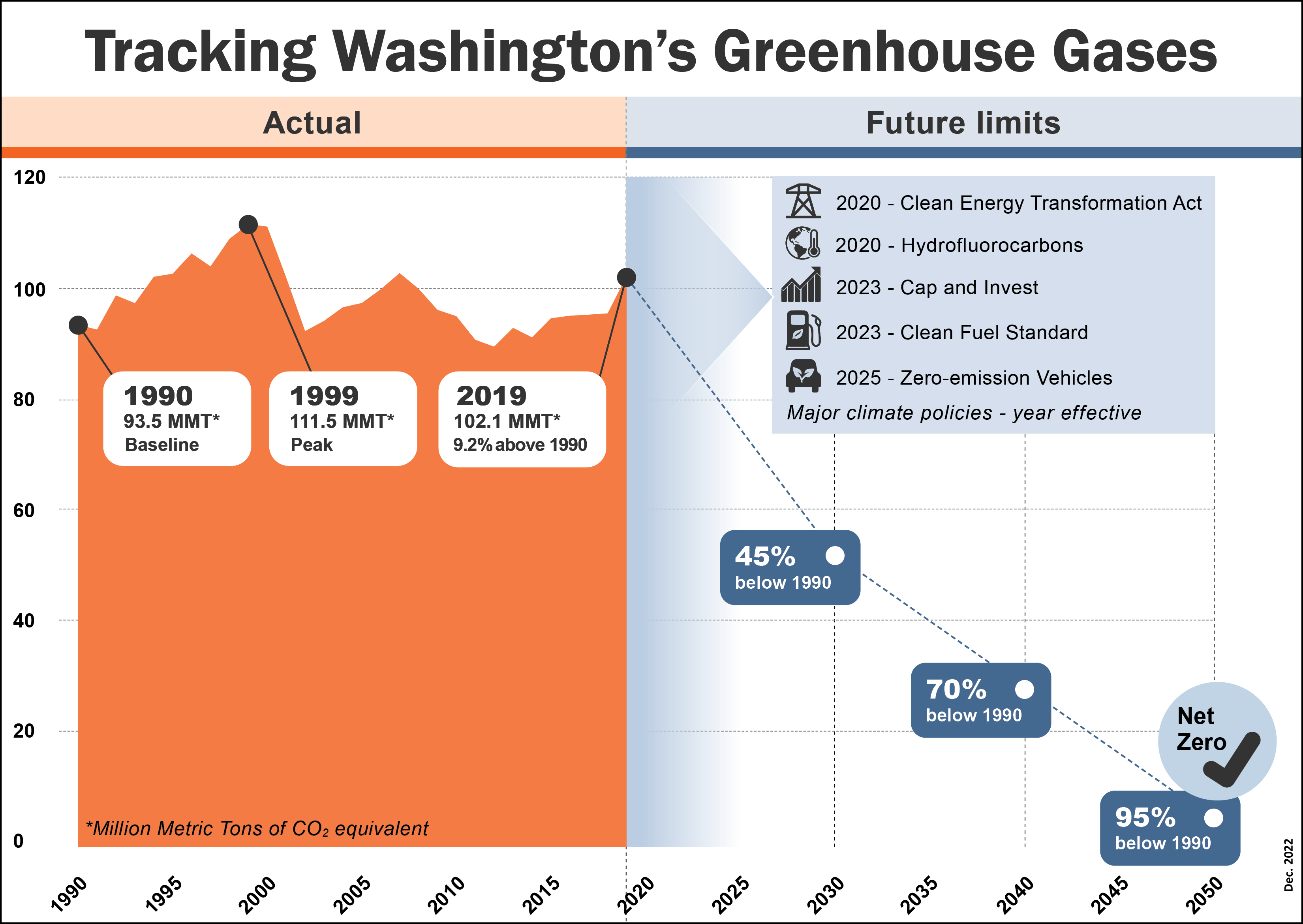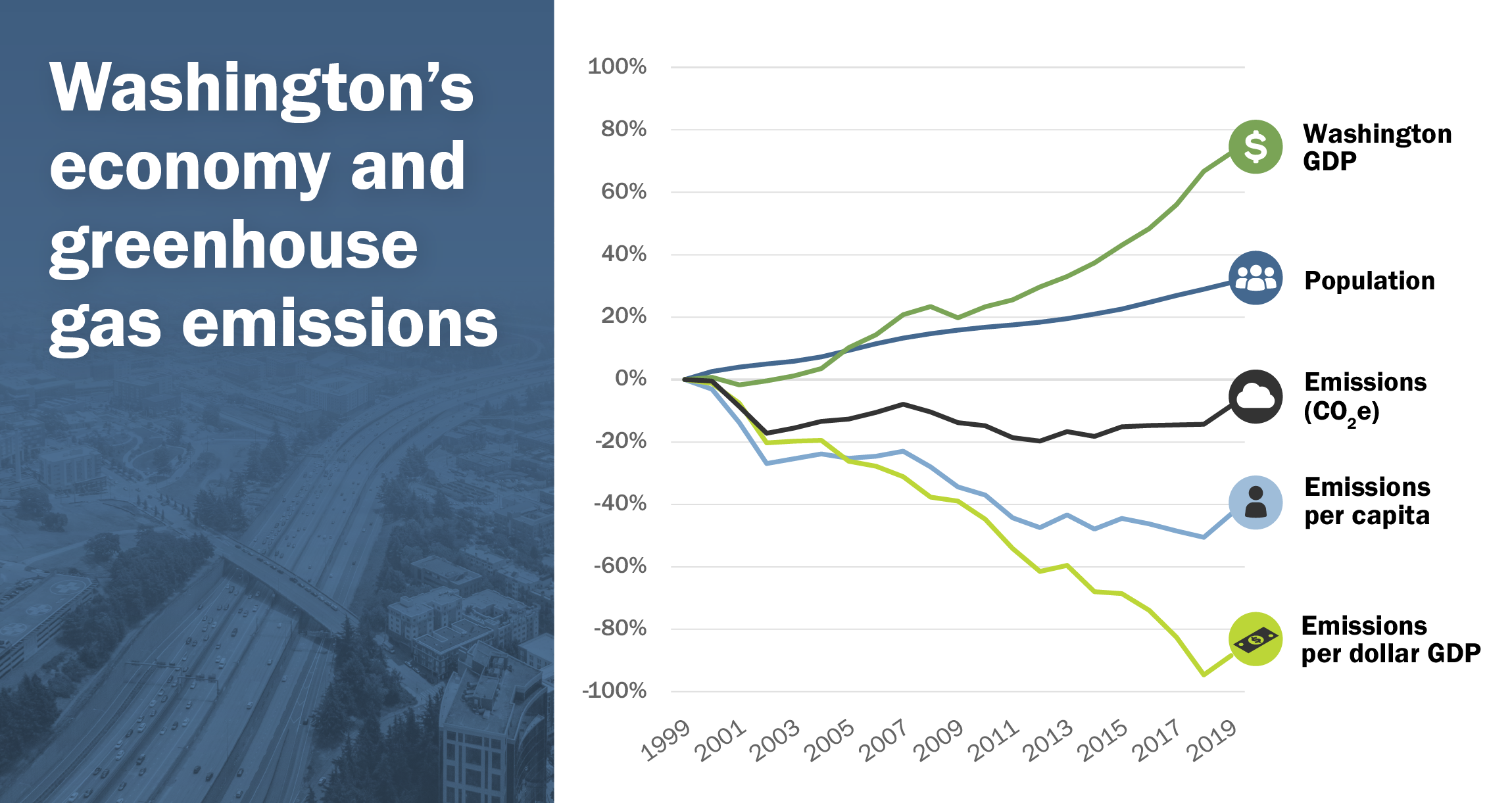
Statewide emissions trended up in 2019, but remain lower than the all-time peak in 1999.
On Jan. 1, 2023, two of the biggest climate policies in Washington’s history will go into effect: The Climate Commitment Act and the Clean Fuel Standard.
But the CCA and the CFS are far from the only ways Washington is working to reduce greenhouse gas emissions and prevent the worst effects of climate change on our state’s environment and economy.
Going all the way back to 2006, our state has launched a range of initiatives designed to bring down carbon pollution and transition from polluting sources of energy. Long story short, a review of these policies shows that they are working as intended – but their biggest effects will be seen in statewide greenhouse gas emissions data for 2020 and beyond, which has yet to be released.
Likewise, it will be several more years before we have clear evidence for how effective Washington’s new climate policies are in reducing emissions. But our experience so far in implementing climate policies should give confidence that we can take action to reduce emissions, and we can do it in a way that allows our state’s economy to continue to thrive.
Let’s take a look:
Energy Independence Act - 2006
In 2006, Washington voters approved Initiative 937, requiring electric utilities with greater than 25,000 customers in Washington to incrementally increase the percentage of power they use from renewable resources to 15% by 2020 (not including existing hydropower generation). Between 2006 and 2020, wind, solar and biomass generation surged. Wind generation in particular soared from less than 1 million megawatt-hours of production in 2006 to more than 5.2 million megawatt-hours in 2020.
Status: Accomplished/ongoing*
*Utilities above the 25,000-customer threshold met the 15% renewable target on time in 2020. Smaller utilities will be added to the program as they grow above that threshold.
TransAlta transition agreement - 2011
The TransAlta Centralia generating plant is Washington’s only coal-fired power plant, and the largest single source of greenhouse gas emissions. In 2011, TransAlta signed an agreement, later codified in state law, that required one of the plant’s two boilers to stop burning coal by the end of 2020, and the second by 2025. The first of the two boilers shut down as scheduled in December 2020.
Status: In progress/on track.
Hydrofluorocarbons - 2019
Hydrofluorocarbons, or HFCs, are a class of chemicals widely used in refrigeration, air conditioning, and other applications. Unfortunately, when HFCs are released into the atmosphere, they have hundreds to thousands of times the climate impacts of carbon dioxide. In 2019, Washington passed restrictions to begin phasing out many common uses of HFCs in favor of climate-safe alternatives between 2020 and 2024.
In 2021, the Legislature expanded the state’s approach to HFCs, covering more equipment and approving a program designed to reduce leaks in commercial heating and cooling systems.
Over time, these measures are expected to reduce statewide greenhouse gas emissions by about 1.4 million metric tons of carbon dioxide equivalent each year.
Status: In progress/on track.
Clean Energy Transformation Act - 2019
In 2019, the Legislature passed a 100% clean electricity law, the Clean Energy Transformation Act (CETA). The law phases out coal from Washington’s electricity supply by the end of 2025, requires electricity consumed in Washington to be carbon-neutral by 2030, and eliminates greenhouse gas emissions from the state’s electricity supply by 2045. Emissions for electricity were responsible for more than 16 million metric tons of greenhouse gas emissions in 2018.
Washington utilities have plans in place to sell their stakes in a Montana coal power plant by 2025 to meet the requirements of the law. Two of the four generating units at that coal plant were closed in 2020.
Status: In progress.
Zero Emission Vehicle standard - 2020
In 2020, the Legislature passed a law requiring manufacturers to sell an increasing number of electric or hydrogen fuel cell vehicles. Ecology adopted rules for the new program in 2021, and the standards will take effect beginning with the 2025 vehicle model year. An update to the rule proposed earlier this year would require all new light duty cars and trucks to meet the zero emission vehicle standard beginning in 2035.
Status: In progress.
Other policies
Because greenhouse gas emissions come from so many different sources, Washington is implementing a range of different strategies to help us cut emissions. Some of these include:
- Sales tax rebates of up to $2,500 for electric vehicles
- Clean building standards for energy efficiency and emissions
- Incentives for solar energy projects that benefit low-income households
- Converting the Washington State Ferry fleet to run on battery-electric power
- Investing $140 million from the Volkswagen settlement in clean vehicles, such as electric school and transit buses
Decarbonizing Washington’s economy
Statewide emissions hit their all-time high in 1999, and have since ebbed and flowed. In recent years, they have been creeping back up – with statewide emissions reaching 102.1 million metric tons of carbon dioxide equivalent in 2019 (the most recent year for which data is available).
When we look at the 20 years from 1999 to 2019, we see that Washington's population and economy grew substantially, but emissions were still well below the peak.
What this means is that our economy is steadily decarbonizing – our economic growth is no longer tied to increasing emissions. Per capita, greenhouse gas emissions are over 40% lower than they were in 1999. Measured as a ratio of emissions per dollar of our state economy, emissions have plunged nearly 90%.
This is progress. But we need a lot more progress if Washington is to meet the strict emission limits set in state law. With the passage of the Climate Commitment Act and the Clean Fuel Standard, we expect to make substantial progress in the coming years.
Washington's economy and population are growing. However, the amount of greenhouse gases we produce per capita and per dollar GDP has been trending down since 1999.


